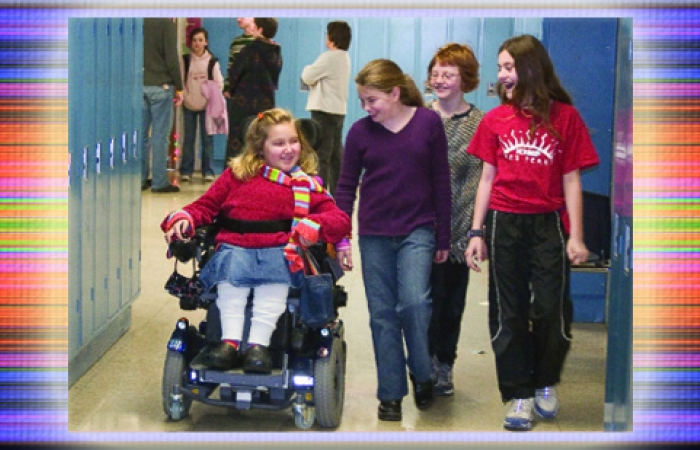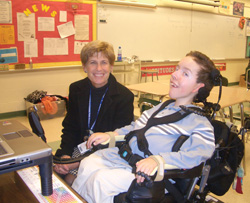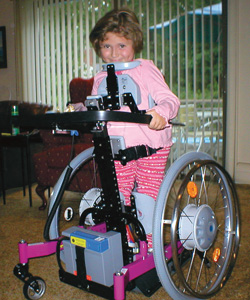
How to Get Your Child's School to Provide Assistive Technology or Help with Learning Disabilities

State and federal law requires school districts to provide assistive technology (AT) and specialized instruction for learning disabilities (LD) to qualifying students.
But parents may have a difficult time convincing their school districts that these services will benefit their child.
Parents stand a better chance of getting special services if they know what to ask for, why they’re asking for it and how to ask for it.
Understand the competing interests
Schools are required to provide AT and LD services only if they’re explicitly written into a child’s IEP, with details explaining how these special services will help the child accomplish “functional” and/or “academic” goals.
(An IEP or individualized educational plan is the blueprint for the education of a child with a disability. By law, IEP meetings must be held at least once a year, but parents, teachers or administrators may call for one at any time. Parents are an integral part of the IEP team and must be notified of all meetings and allowed to be present if they choose.)
According to IDEA 2004 (the federal law governing special education), school districts can’t deny special education services because of cost. But the tension between what parents want and what school districts believe they can afford is inherent in every IEP meeting.
This level of tension will vary based on the school district, and “the available resources, budget and attitude,” says Al Freedman, a child and family psychologist in West Chester, Pa., whose son, Jack, 12, is in sixth grade and was diagnosed with type 1 spinal muscular atrophy at 6 months.
Despite this tension, success is possible. For example, Jack’s IEP includes multiple pages of special services. In addition to OT, PT, and speech/language therapy services, his IEP calls for: Kurzweil scan and read software; Reach on-screen keyboard; Mathpad computation software; laptop computer (for use at home and school); trackball mouse; video conferencing equipment (for use at home when Jack’s sick); and training for the teacher and aides regarding technology and physical needs.
Collaborate, don’t demand
“The problem and the joy of IDEA is that [special education] decisions are made on an individualized basis,” observes Gayl Bowser, an independent AT consultant. Bowser is a retired special education teacher and AT specialist for the Oregon Department of Education.
 “IDEA is the law, but the place where districts may hesitate, or be resistant, to provide AT is when there’s a disagreement over whether the technology is needed in the first place.”
“IDEA is the law, but the place where districts may hesitate, or be resistant, to provide AT is when there’s a disagreement over whether the technology is needed in the first place.”
To avoid this stalemate, parents first must create an atmosphere of trust and collaboration on the IEP team. Share information, listen, and ask questions that will facilitate the team’s ability to come up with solutions.
A parent who walks into an IEP meeting demanding AT or LD services because they’re required by law isn’t going to get as positive a response as a parent who says, “my child has a neuromuscular disease, and he’s losing his ability to write with a pencil, so how are we going to address this?” says Bowser.
When requesting special services, Freedman advises fellow parents to “view your teachers and members of the IEP team as partners who are there to help your child.”
Many school districts don’t have extensive experience providing accommodations for children with neuromuscular diseases. Share all of your research and information with the IEP team and why you think your request is beneficial for your child. Then ask: What do you know about this?
“It’s a matter of putting your ideas together and seeing what makes the most sense,” Freedman says.
Keep an open mind
Bowser suggests that parents start by looking for simpler ways to solve problems, rather than automatically jumping to the most high-tech, complicated solution right off the bat.
“It’s a common mistake parents make because they want the best for their child,” Bowser says. “Voice-recognition technology is difficult to use and complicated. It sounds wonderful and magical, but you have to understand how the technology works if you’re going to fight for it, and you need to make sure that it’s the right tool for your child.”
Freedman also suggests that parents be active in the evaluation process. Gather as a group and discuss whether current AT devices or other modifications are working well, or if something else should be tried.
While schools are responsible for providing AT equipment per the IEP team’s recommendations, parents can work with the school to locate “trial” AT equipment to determine if a certain device is appropriate for their child. Parents also can help locate AT devices for temporary usage, such as while waiting for new equipment that’s on order.
Parents can borrow devices from local AT lending libraries, as well as from equipment loan programs offered through the State AT Act projects.
And, parents can visit the Alliance for Technology Access Center (www.ataccess.org) in their area. The centers typically provide no- or low-cost AT assessments and consultations, where children with disabilities can try a variety of software and AT devices.
“If we know something has worked for our son and will benefit him, and the process and results have been documented, then there’s a higher likelihood that the IEP team members will agree,” Freedman says.
Consultants who specialize in AT and provide technical assistance to school districts are valuable IEP team members. They help identify a need for AT; formulate language for the IEP; assess the quality of accommodations; help identify possible solutions based on evaluations; and train the school staff.
If there’s not an AT consultant on your child’s IEP team, request one. If necessary, work with the school’s special services department to locate the district’s state-funded AT point person. Or, contact your State AT Act program to locate the state-funded consultants and evaluators that may be assigned to your school district.
Getting LD services
If your child has a learning disability (LD) in addition to a neuromuscular disease, communication is the key to ensuring that the IEP team focuses on your child’s learning goals as well as physical adaptations.
“It’s a two-way street. You have to ask questions, and share information about what’s going on at home in order to work with the teachers in coming up with the entire picture of the student’s performance,” says Renee Rolwes of Fenton, Mo.
 Rolwes’ son, Corey, 7, has Duchenne muscular dystrophy (DMD), and receives speech and language services and reading intervention in addition to physical therapy and consultations for occupational therapy. The services are outlined in detail in the second-grader’s IEP.
Rolwes’ son, Corey, 7, has Duchenne muscular dystrophy (DMD), and receives speech and language services and reading intervention in addition to physical therapy and consultations for occupational therapy. The services are outlined in detail in the second-grader’s IEP.
To stay on top of Corey’s progress, Rolwes speaks with his general education teacher at least three times a month, and corresponds with the speech and language teacher at least once a month. In addition to asking questions about Corey’s performance at school, Rolwes shares information about his homework performance at home.
Teachers don’t see everything that goes on in the classroom, she explains, so more information enables them to spot problems and make appropriate recommendations at IEP meetings.
Thanks to this close communication, Corey’s teacher approached Rolwes about his progress in writing expression and reading. An official IEP meeting was convened and the team agreed that Corey needed to be re-evaluated in those areas, as well as in OT and cognitive skills.
Once the test results come back, Corey’s team will reconvene, examine the results, make recommendations and rewrite his IEP.
Rolwes says the IEP team has taken a very proactive approach to Corey’s education, even though his future is uncertain due to DMD.
“My teachers haven’t written him off. They want him to keep up, and they want him to succeed.”
Build your case
A blind request for AT or LD services is more likely to result in a “no.” A knowledgeable request can be made by incorporating reports, evaluations, test results and your own observations.
Because independent evaluations and consultations are expensive, parents should start by requesting a school-funded evaluation. If there’s been a change in physical skills or academic performance, or if a parent wants an updated evaluation, an IEP meeting must be held to discuss it.
At the meeting, present evidence of your child’s changes in physical or academic abilities by tracking grades, displaying samples of the child’s work and documenting the child’s ability to complete homework. Share photos or videos of the child’s physical abilities at home.
The IEP team has the final say, so the more hard data and documentation you can present, the better the chances of getting an evaluation.
In some cases, the school district may pay for a private evaluator if it doesn’t have the personnel to conduct an evaluation recommended by the IEP team, or if the district agrees that an independent evaluation is necessary for some other reason.
But if the district refuses to do an evaluation, or if the district’s evaluator recommends something parents believe is not appropriate, then parents may choose to get their own independent evaluation. In this case, parents are responsible for the cost, which can vary based on the extent of the evaluation.
Independent educational evaluators can help show how physical or learning disabilities impact the child’s education, and why a particular service is needed to offset this impact. And since they don’t answer to the school district, they may provide more objective evaluations.
When parents present data from independent evaluations, the IEP team is required to consider these evaluations before making a final decision, says Wayne Steedman, a special education law attorney and advocate in Baltimore.
Steedman recommends that the independent evaluator or expert be present at the IEP meeting to thoroughly explain the recommendations and answer questions.
To find an independent educational consultant or evaluator, check out Wrightslaw’s Yellow Pages for Kids, which lists several resources by state. Or, contact local Parent Training and Information Centers to find experts and resources in your area.
Find a solution, avoid due process
Due process hearings are expensive and time-consuming, and should be avoided, cautions Steedman. It’s possible to find solutions without going to court.
Mediation sessions, which are required prior to a court hearing, can be fruitful. Unlike a court hearing, where one side wins and the other loses, mediation gives parties a chance to compromise and collaborate.
For example, second-grader Desiree Sheehy of Franklin Lakes, N.J., has type 2 spinal muscular atrophy, and has been using the Easy Up n’ Go partial weight-bearing system at home since February 2006.
However, the school district wouldn’t allow Desiree, 8, to use the device at school, arguing that her physical therapy sessions provided the same benefits, says Linda Sheehy, Desiree’s grandmother.
 Desiree’s IEP team disregarded the recommendations of both the school’s physical therapist and Desiree’s physician supporting her use of the device. After months of frustration and stalemate, the Sheehys filed a due process petition stating the district blocked them from influencing Desiree’s education plan, including her PT program.
Desiree’s IEP team disregarded the recommendations of both the school’s physical therapist and Desiree’s physician supporting her use of the device. After months of frustration and stalemate, the Sheehys filed a due process petition stating the district blocked them from influencing Desiree’s education plan, including her PT program.
Before going to court, the Sheehys and school district officials participated in multiple mediation sessions, which ultimately resulted in a confidential agreement that allows Desiree to use a motorized stander called a Standing Dani in school every day. The Standing Dani is now written into Desiree’s IEP.
“The fact that they’re cooperating with me on the stander and that she’s getting into it for an hour a day is a good thing for Desiree,” Sheehy said. “I nearly ended up going to court because the whole process was so frustrating. Nobody should have to go through that.”
Steedman recommends that parents have legal representation and/or an AT or special education expert present at mediations, even though they’re not required to do so. These experts may stand a better chance than parents of initiating informal, unemotional discussions with school district officials.
An attorney and/or advocate can help strengthen relationships and build trust among the parties, Steedman says, while an AT expert can more convincingly discuss why the child will not receive an appropriate education without a particular AT device.
“You have to go in there with the idea that it’s like preparing for a football game. You’re the coach of Podunk High School, and you’re preparing your team to play the New England Patriots,” Steedman explains.
“You’re the underdog, so you need to have a game plan that’s set up nicely so that you can give them the information and get them to come around to your side.”
To represent or not to represent ...
In May 2007, the United States Supreme Court issued a unanimous (9-0) decision in Jacob Winkelman v. Parma (Ohio) City School District, granting parents the right to represent their children without an attorney in federal due process hearings.
In its ruling, the Supreme Court emphasized that IDEA (the federal law governing special education) doesn’t differentiate between the rights accorded to children and the rights accorded to parents.
In other words, if the parents’ rights were denied, or if the school system left them out of the IEP process, parents can argue that the school violated their child’s rights as well, says Wayne Steedman, a special education law attorney and advocate in Baltimore.
The ruling bolstered IDEA, which mandates that parents have the right to participate in the IEP process and are entitled to help formulate their child’s educational program.
But in practical terms, Steedman cautions that arguing a case in federal court “is not easy even for attorneys who’ve been trained in it. If parents run in without an attorney, they’re not going to get far unless they really know what they’re doing.”
To read the Court’s full opinion, visit www.supremecourtus.gov/opinions/06pdf/05-983.pdf.
MDA Resource Center: We’re Here For You
Our trained specialists are here to provide one-on-one support for every part of your journey. Send a message below or call us at 1-833-ASK-MDA1 (1-833-275-6321). If you live outside the U.S., we may be able to connect you to muscular dystrophy groups in your area, but MDA programs are only available in the U.S.
Request Information